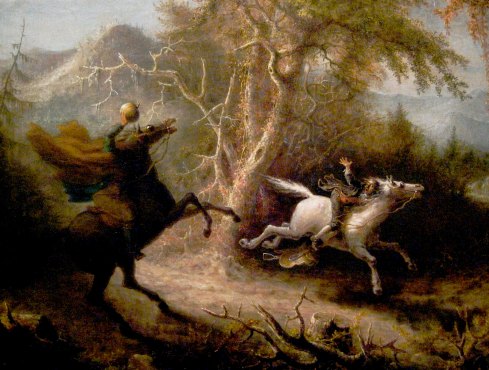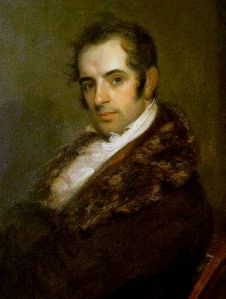“…The old country wives, however, who are the best judges of these matters, maintain to this day that Ichabod was spirited away by supernatural means; and it is a favourite story often told about the neighbourhood round the winter evening fire. The bridge became more than ever an object of superstitious awe, and that may be the reason why the road has been altered of late years…The schoolhouse being deserted, soon fell to decay, and was reported to be haunted by the ghost of the unfortunate pedagogue; and the plough-boy, loitering homeward of a still summer evening, has often fancied his voice at a distance, chanting a melancholy psalm tune among the tranquil solitudes of Sleepy Hollow.”
My favorite ghost story as a kid. I still remember the profound frustration of not knowing exactly what happened to Ichabod Crane. Questions abounded. As it turns out, looking a bit into the history of “Sleepy Hollow,” there are just as many questions about the origins of the story itself.
Washington Irving (1783-1859) published “The Legend of Sleepy Hollow” in 1819 as part of a collection of stories titled The Sketch Book of Geoffrey Crayon. Also included was the classic “Rip Van Winkle.” The stories propelled him to fame. He is often lauded as the first great American writer and his tales the first great works inspired by uniquely American folklore.
Americans were suffering from a cultural inferiority complex at the time and Irving gave them a sense of a national mythology that was just their own. He painted a picture of a haunting and magical Hudson River Valley, rich with the folklore of the descendants of Dutch settlers. He claimed that he learned this folklore as a teenager. In 1793, during an outbreak of yellow fever, he was sent by his parents from his home in Manhattan to stay with friends up river in Tarrytown. Over the next several years he would visit other locations in the Hudson River Valley and purportedly heard many an old Dutch legend which influenced his writing.
The origins of the “The Legend of Sleepy Hollow” are debated, hotly at times, by scholars and journalists. Were the characters based on actual people? If the story was based on old folklore, as the author suggested, where did he hear these stories? And where was Sleepy Hollow?
I have, while on my way to the Tappan Zee Bridge, many times seen the exit signs for Sleepy Hollow and assumed that it was a historical place, so named since Irving’s time. Not so.
In the story, Irving describes Sleepy Hollow as being “perhaps about three miles” from Tarrytown on the Hudson River. It was in “a little valley or rather lap of land among high hills, which is one of the quietest places in the whole world…” This could be a variety of places, or purely fictitious for that matter. But the village of North Tarrytown, where Irving was buried, has long laid claim to being the inspiration for “Sleepy Hollow.”
This notion has been contested and many, including President Martin Van Buren, have claimed that Irving based his story on Kinderhook, New York, the president’s birthplace. Irving had spent a few weeks in Kinderhook in 1809 and apparently based several key characters after actual people there. In an effort, perhaps, to settle the matter once and for all, in 1996 the village of North Tarrytown renamed itself Sleepy Hollow. I doubt that pleased the Kinderhook camp.
Another of the questions surrounding the story is the identity of the famous Ichabod Crane. Fictitious, or inspired by a historical figure? There was, in fact, an actual Ichabod Crane. A career soldier born in Elizabeth, New Jersey in 1787, Crane served as a Marine and later a U.S. Army officer. During the War of 1812, he was stationed on the Canadian front at Fort Pike in Sackett’s Harbor, New York. Irving served for a time as an aide-de-camp to Governor Daniel Tompkins who played an active role in organizing New York’s defenses. While at Fort Pike in 1814, Irving met Major Crane. That name, Ichabod Crane…that splendid name, just the sound of it evoking images of a gangly Yankee schoolmaster, apparently stuck in Irving’s mind. The soldier was nothing like the character, but the name would be stolen nonetheless. After the story was published, Major Crane apparently resented being associated with such a laughable character, even if only by name.
The character of Ichabod Crane was, according to some, inspired by an actual Yankee schoolmaster whom Irving befriended when he stayed in Kinderhook. Jesse Merwin, originally from Connecticut, had settled in Kinderhook and taught school there. After the story was published, Merwin produced correspondence from Irving proving that the two knew each other. Unlike Major Crane, schoolmaster Merwin seems to have been proud of his association with the story.
And what of the Headless Horseman himself? In the story, he is the ghost of a Hessian soldier from the Revolutionary War, beheaded by a cannonball in some unnamed battle, who travels nightly in search of his head. Some have argued that this was a local tale told to Irving when he lived along the Hudson, and old bit of folklore that actually preceded the Revolution passed down by the descendants of Dutch settlers. Others have pointed to older European traditions, arguing that Irving was inspired by legends of the “Wild Huntsman,” a ghostly rider who terrified nighttime travelers with his pack of hounds in Medieval Germany. Irving did indeed visit Germany and learned a great deal of its folklore, but not until after he wrote “Sleepy Hollow.” So, exactly how and where Irving got the idea for his Headless Horseman is unclear. But he was definitely not the first to, at least verbally, tell the tale of a headless, ghostly rider.
An aspect of the back-story that I find most intriguing was highlighted by Judith Richardson in her recent book Possessions: The History and Uses of Haunting in the Hudson Valley. In 1815, while in a tough financial spot, Irving went to England (as many American writers of that era did) to learn from the established literary circles there and perhaps get a much-needed boost to his career. He would remain in England for many years. It was in Birmingham that he wrote “Rip Van Winkle” in 1817 and “Sleepy Hollow” in 1819.
Ironically, it was probably not his youthful years among the rural descendants of Dutch settlers in the Hudson River Valley that so shaped his writing, but the romanticism of English writers such as Samuel Coleridge and Walter Scott. Scott was a particularly prominent figure in Irving’s life, becoming a mentor to him and a life-long friend.
Thus, it seems that Irving was not so much influenced by the rich folklore of the Hudson River Valley as the other way around. Inspired by the writings of English and Scottish romantics, Irving infused his native region with ghosts, sprites and spirits…all transplanted, as it were, from the Scottish Highlands by the author.
[Sources: Jonathan Kruk, Legends and Lore of Sleepy Hollow and the Hudson Valley (2011); Judith Richardson, Possessions: The History and Uses of Haunting in the Hudson Valley (2005)]



October 31st, 2011 at 3:48 pm
Aunt Judy’s favorite story….. BOO!
As for me until I learned more about 19th century mourning and superstitions, I had no idea that the reason Crane would have been safe until after he crossed the bridge was due to the fact that spirits cannot cross over water…. was that fact made clear in the original story? I don’t recall, it’s been too many years.
Thanks for the spooky tale…….
November 1st, 2011 at 7:36 am
“If I can but reach that bridge,” thought Ichabod, “I am safe.”
He does include it in the story. Brom tells Ichabod that the Horseman exploded into flames when he tried to follow him across the bridge. Good stuff.
November 15th, 2013 at 5:16 pm
I just recently found out that, my husband & his family are direct descendants of Jesse Merwin, so hearing this is really cool!! I am sharing this with our kids & they can say they are related to the real Ichabod Crane!! Thanks for the info, very interesting facts!! I was looking through our family genealogy book & found this info to be very accurate!!
November 15th, 2013 at 5:39 pm
How great is that? What a wonderful thing to be able to say that “Ichabod Crane” is your ancestor. Glad you found this information helpful.
Best,
Patrick
October 6th, 2014 at 12:39 am
Thanks for the background information to this story, It’s aways been one of my favorites, and it’s interesting to see who might have been the inspiration behind Ichabod’s character.
Have you since found any clearer connections between Coleridge’s and/ or Scott’s romances and Irving’s Headless Horseman, though? Thanks again.
November 14th, 2014 at 11:53 pm
[…] of the Headless Horseman. OK, it has been claimed since, at least, the 1930s that Washington Irving borrowed from German folk tales when he penned both “The Legend of Sleepy Hollow” and “Rip van Winkle,” but […]
December 23rd, 2014 at 11:59 am
[…] Washington Irving. The TV show is set in the Tarrytown, New York area (dismissing by default Kinderhook, New York’s claim to be the setting of Irving’s story). It even has a character named “Frank Irving”, giving […]
March 29th, 2015 at 8:50 pm
Although there has been speculation that Kinderhook was Sleepy Hollow that’s not correct. Sleepy Hollow is and always has been Sleepy Hollow–the original name for the village of North Tarrytown. Offici changed the name to North Tarrytown in 1883 but in 1996 the name was changed back to the original–not to settle disputes but to return to its roots, gain its own identity and to focus on tourism when GM plant closed. As a child growing up in Yonkers, south of Tarrytown there was a sign acknowledging the origins as well as Irvings tale.
April 6th, 2015 at 6:50 am
Hi Denise,
Thanks for commenting and supplying this information. It is very interesting that the origins of the name Sleepy Hollow are rooted in earlier history. I will edit the article to reflect this. I was not attempting to advance the Kinderhook theory, simply reporting that such a theory existed.
Best,
Patrick
October 10th, 2015 at 1:10 am
[…] Historical Digression has more about the story. […]
May 10th, 2016 at 11:25 pm
[…] Historical Digression has more about the story. […]
November 2nd, 2016 at 1:04 am
[…] autumnal flight through the woods undoubtedly trotted through millions of minds recently. Irving Washington’s “The Legend of Sleepy Hollow” is perhaps America’s most enduring ghost story. Washington wrote the story in 1820. I know […]